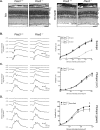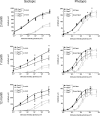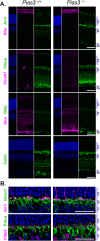Pias3 is necessary for dorso-ventral patterning and visual response of retinal cones but is not required for rod photoreceptor differentiation
- PMID: 28495965
- PMCID: PMC5483026
- DOI: 10.1242/bio.024679
Pias3 is necessary for dorso-ventral patterning and visual response of retinal cones but is not required for rod photoreceptor differentiation
Abstract
Protein inhibitor of activated Stat 3 (Pias3) is implicated in guiding specification of rod and cone photoreceptors through post-translational modification of key retinal transcription factors. To investigate its role during retinal development, we deleted exon 2-5 of the mouse Pias3 gene, which resulted in complete loss of the Pias3 protein. Pias3-/- mice did not show any overt phenotype, and retinal lamination appeared normal even at 18 months. We detected reduced photopic b-wave amplitude by electroretinography following green light stimulation of postnatal day (P)21 Pias3-/- retina, suggesting a compromised visual response of medium wavelength (M) cones. No change was evident in response of short wavelength (S) cones or rod photoreceptors until 7 months. Increased S-opsin expression in the M-cone dominant dorsal retina suggested altered distribution of cone photoreceptors. Transcriptome profiling of P21 and 18-month-old Pias3-/- retina revealed aberrant expression of a subset of photoreceptor genes. Our studies demonstrate functional redundancy in SUMOylation-associated transcriptional control mechanisms and identify a specific, though limited, role of Pias3 in modulating spatial patterning and optimal function of cone photoreceptor subtypes in the mouse retina.
Keywords: Cell type specification; Gene regulation; Mouse knockout; Retina development; SUMOylation; Vision.
© 2017. Published by The Company of Biologists Ltd.
Conflict of interest statement
Competing interestsThe authors declare no competing or financial interests.
Figures







Similar articles
-
Pias3-dependent SUMOylation controls mammalian cone photoreceptor differentiation.Nat Neurosci. 2010 Sep;13(9):1059-65. doi: 10.1038/nn.2618. Epub 2010 Aug 22. Nat Neurosci. 2010. PMID: 20729845 Free PMC article.
-
Pias3-dependent SUMOylation directs rod photoreceptor development.Neuron. 2009 Jan 29;61(2):234-46. doi: 10.1016/j.neuron.2008.12.006. Neuron. 2009. PMID: 19186166 Free PMC article.
-
A mouse M-opsin monochromat: retinal cone photoreceptors have increased M-opsin expression when S-opsin is knocked out.Vision Res. 2011 Feb 23;51(4):447-58. doi: 10.1016/j.visres.2010.12.017. Epub 2011 Jan 8. Vision Res. 2011. PMID: 21219924 Free PMC article.
-
The transcription factor GTF2IRD1 regulates the topology and function of photoreceptors by modulating photoreceptor gene expression across the retina.J Neurosci. 2014 Nov 12;34(46):15356-68. doi: 10.1523/JNEUROSCI.2089-14.2014. J Neurosci. 2014. PMID: 25392503 Free PMC article.
-
Thyroid Hormone Signaling in Retinal Development, Survival, and Disease.Vitam Horm. 2018;106:333-349. doi: 10.1016/bs.vh.2017.05.001. Epub 2017 Jun 19. Vitam Horm. 2018. PMID: 29407441 Review.
Cited by
-
The role of SUMOylation during development.Biochem Soc Trans. 2020 Apr 29;48(2):463-478. doi: 10.1042/BST20190390. Biochem Soc Trans. 2020. PMID: 32311032 Free PMC article. Review.
-
Expression of deubiquitinating enzyme genes in the developing mammal retina.Mol Vis. 2019 Dec 2;25:800-813. eCollection 2019. Mol Vis. 2019. PMID: 31819342 Free PMC article.
-
Targeted deletion of an NRL- and CRX-regulated alternative promoter specifically silences FERM and PDZ domain containing 1 (Frmpd1) in rod photoreceptors.Hum Mol Genet. 2019 Mar 1;28(5):804-817. doi: 10.1093/hmg/ddy388. Hum Mol Genet. 2019. PMID: 30445545 Free PMC article.
-
Samd7 represses short-wavelength cone genes to preserve long-wavelength cone and rod photoreceptor identity.Proc Natl Acad Sci U S A. 2024 Nov 19;121(47):e2402121121. doi: 10.1073/pnas.2402121121. Epub 2024 Nov 12. Proc Natl Acad Sci U S A. 2024. PMID: 39531499 Free PMC article.
-
Molecular mechanisms controlling vertebrate retinal patterning, neurogenesis, and cell fate specification.Trends Genet. 2023 Oct;39(10):736-757. doi: 10.1016/j.tig.2023.06.002. Epub 2023 Jul 8. Trends Genet. 2023. PMID: 37423870 Free PMC article. Review.
References
-
- Applebury M. L., Antoch M. P., Baxter L. C., Chun L. L. Y., Falk J. D., Farhangfar F., Kage K., Krzystolik M. G., Lyass L. A. and Robbins J. T. (2000). The murine cone photoreceptor: a single cone type expresses both S and M opsins with retinal spatial patterning. Neuron 27, 513-523. 10.1016/S0896-6273(00)00062-3 - DOI - PubMed
Grants and funding
LinkOut - more resources
Full Text Sources
Other Literature Sources
Molecular Biology Databases

